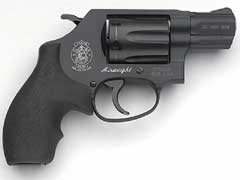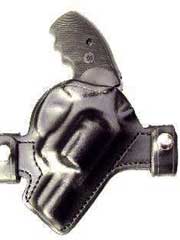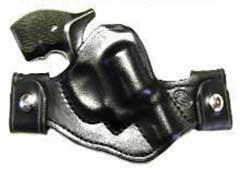|
Smith & Wesson (S&W) has been producing
small, solid frame .32 revolvers on a near continuous basis for
the best part of 108 years.
The first was designed around the new I-Frame and called
the .32 Hand Ejector Model of 1896.
Along with this swing-out cylinder revolver came the .32
S&W Long cartridge. Produced
by lengthening the .32 S&W case by 1/8”, the .32 Long
allowed for a more powerful load.
This model became issue guns for the Jersey City and
Philadelphia police forces, along with numerous others over the
succeeding years. As with all S&W handguns, the .32 Hand Ejector went
through a series of evolutionary steps as new improvements were
made and newer models introduced.
The Post-WWII era saw the emergence of the J-Frame and
the S&W “Regulation Police” or Model 31 was changed to
this frame size in 1961. This
model was the last in a long lineage of .32 wheel guns and in
the early 1990’s it looked like the end was near.
Enter the .32 H&R Magnum.
The same year the Model 31 went out of production (1991), it
had already been replaced by the Model 631 and a concealed
hammer “Centennial Model” 632 followed shortly.
The bragging rights for the .32 Magnum was that it
provided much the same power as standard velocity .38 Specials,
but would chamber in a J-Frame with a 6-shot cylinder.
Federal manufactured two loads for the .32 Magnum,
a 95 gr. lead flat point (listed on the box as a SWC) and an 85
gr. JHP. Factory
velocity figures hovered around 1000 FPS in longer barrel
six-guns. Over the
ensuing years, production of S&W J-Frame revolvers in .32
Magnum has fluctuated and during some years there was no listing
for the .32 Magnum in S&W catalogs.
But, the .32 Magnum Smith just keeps coming back.
The latest rendition of the .32 Magnum J-Frame is the Model
431PD and Model 432 PD Airweight 6-shot “snubbies.” Both of these guns have aluminum alloy frames and barrel
shrouds that protect the ejector rods and form a rib atop the
enclosed 1-7/8” steel barrel insert.
Both have fixed sights and non-reflective matte blue
finishes, plus Hogue rubber combat-style grips.
The main difference between the two revolvers, as you
might have guessed, is the Model 431PD has an exposed hammer and
is a traditional double-action, while the Model 432PD has an
internal hammer and is double-action only (DAO). Both also feature the latest improvements S&W has made on
their revolvers, such as a cylinder stop integral with the
frame, redesigned cylinder release latches and hammer-locking
safety device incorporated into the action.
The Model 431 PD also has an inertia firing pin mounted
inside the frame, replacing the old firing pin that was once
riveted into the hammer nose on all S&W exposed hammer
revolvers.
I asked S&W to have a sample of both six-shooters
forwarded to me ASAP. The
two guns arrived in record time in the usual blue plastic, foam
padded cases. Inside
was found a plentitude of literature, a padlock with a flexible
hasp to run down the barrel (just in case the internal hammer
lock isn’t enough for you) and a small plastic tool used to
remove the Hogue grips. A
check of both guns exterior surfaces showed clean lines and a
quality fit and finish. These
are totally black guns and in a departure from the old-line
Smith & Wesson revolvers, even the hammer and trigger are a
matte finish instead of color-case hardened.
The back strap, outer trigger guard surface and the inner
surface of the trigger guard have cut-outs to lessen the weight
a tad. In my humble
opinion, S&W has gone a little overboard on putting the logo
on both sides of the frame, the large logo a laser-etched white,
along with a large cursive “Airweight” of the same
coloration, which I could do without.
The front sight on both guns is a 1/8” serrated
ramp-style and the rear is fixed with a well defined square
notch cut in the frame. The
single action pull on the S&W Model 431PD was crisp and
about 4 Lbs. while the DA pull ran about 13 Lbs. as did the DAO
pull on the Model 432PD.
For these light-weight, highly concealable “belly guns”
I wanted some leather that would aid rather than detract from
their “conceal-ability.”
The holsters I had in mind would not only do that, but
had an easy on, easy off feature to boot.
A call to Lefty Lewis of Bell Charter-Oak
Company resulted in the receipt of two of his latest models,
the “Co-Pilot” and the “Charter Jet.”
I will have to say that these holsters are some beautiful
examples of the leather crafter’s art.
Fashioned from tough harness leather, they are wet case
molded for positive retention, with a durable lock-stitching and
an open muzzle. This
molding is no BS, I can tell you for a fact, as I inserted the
revolvers into the holsters and gave them a vigorous shaking.
Even with the holsters held upside down, the guns did not fall
out. Yet, they are
easily drawn when pulled straight upward.
The “Co-Pilot” is a highly successful design and Lefty
tells me they have a hard time keeping up with the demand.
My sample was several years old, but looks like it was
made yesterday, with its custom mahogany finish and optional
mouth-band reinforcement. The
snap fastening feature allows the holster to be put on or taken
off without removing the trouser belt.
Although meant to be a crossdraw, I took Lefty’s
suggestion and wore it dominant side in the appendix position.
Worn this way, the holster allows a “speed rocker”
type draw which not only makes for a rapid presentation, but
levels the muzzle on the target at close quarters as soon as the
muzzle clears leather. You
can bet this rig will see some miles riding on my belt!
My sample “Charter Jet” was dyed black and as it was
designed for the dominant side was not as wide as the
“Co-Pilot.” It
sported a nice glossy finish and is also snap- fastened on the
belt. Lefty tells
me that it is a favorite holster for female law enforcement
officers as it positions the weapon midway on the beltline,
unlike other high-ride rigs that position the gun butt right up
under the arm pit, making a smooth draw difficult.
Short-waisted men find them comfortable, anatomically
compatible and concealable too.
The .32 H&R Magnum is not exactly the darling of the
ammunition producers, and is currently available from only a few
manufacturers. As I wanted the most current loads available, I
got on the phone and made some orders.
Well known to shooters is Black Hills Ammunition,
and they catalog two loads for the .32 Magnum.
One is their mild-mannered “cowboy” load with a 90
gr. lead flat point bullet traveling at a leisurely velocity.
It makes for a good training, practice and plinking load.
Newly manufactured “Red Box” ammo is also available
and sports what looks like a Hornady 85 gr. XTP
hollow-point bullet. Federal,
the original maker of the .32 Magnum offers an 85 gr. JHP load
and a 95 gr. lead flat point load.
These loads were originally meant
to offer the power of a .38 Special standard velocity
load in a .32 bore.
A producer that is new to me is Georgia Ammunition,
although they have been in business some 24 years. A look at their web site shows they produce an extensive line
of self-defense, hunting and Cowboy Action Shooting ammunition.
They market a .32 Magnum load that has a 100 gr. JHP
bullet at an advertised velocity of 1100 FPS. The bullet is a conventional, exposed lead tip HP design.
My last test cartridge in this caliber came from MagSafe.
It is their .32 Magnum “Defender” load and features a
“pre-fragmented” 50 gr. jacketed bullet, at an advertised
1700 FPS from a 6” barrel Ruger revolver. The revolutionary bullet is essentially a bullet jacket that
is hand filled with #2 and #3 lead shotgun pellets which are
capped with an epoxy resin blend.
The combination of pellets and resin allow stability of
bullet flight along with proper fragmentation and penetration
when the bullet hits the target.
Now that I had all the components of guns, leather and
ammunition, it was time to head to the range.
A sunny, late September day was perfect shooting weather,
and I set up in the shade of some large hardwood trees.
As is my usual practice, the first order of business was
to set up my Oehler Model 35P chronograph and see what
kind of velocities I would get from the 1-7/8” barrel of the
S&W snubby and the .32 H&R Magnum factory cartridges.
I decided not to chronograph both guns as some of my
ammunition was in short supply, so I used only the Model 431PD.
I will have to state that I was pleasantly surprised with
the velocities I obtained from the several defense oriented
loads. The Black
Hills “cowboy load” also performed as expected. You can see the results in the accompanying chart.
Accuracy testing was done from a bench rest, using a sandbag
at 15 yards, which I feel is a realistic distance for a short
barrel revolver or autoloader.
I made a presumption that the traditional DA of the
S&W Model 431PD would “eat the lunch” of the DAO Model
432PD, but again I was surprised.
It was no surprise that the Black Hills “cowboy load”
did the best in the Model 431, with a group measuring 1.85”.
Second place went to the Federal cartridge and third to
the Black Hills 85 gr. JHP.
The Georgia Ammunition ad MagSafe Defender, were only
fractions of an inch behind.
The DAO Model 432PD actually had the best group of the
day at 1.82” with the Georgia Ammunition.
Black Hills “cowboy” was second and the Magsafe
Defender third. Again,
look to the chart for more information.
Combat shooting was next on the agenda, and I fired several
30 round courses using the two S&W revolvers and the two
different holsters. There
were four different stages at 3, 7 and 15 yards, utilizing
point, sighted and barricade shooting, plus combat reloading
under time limitations. For
the reload I used a “dump pouch” made for the trouser belt
out of black nylon. The
pouch would accommodate seven .32 Magnum cartridges, which left
me a spare if I happened to drop a round.
That seventh round also seemed to want to stay put in the
carrier, which I felt was a good thing.
All of the shooting was done with the Black Hills .32
Magnum JHP, and a B-27 Silhouette target from Birchwood Casey
was affixed to my portable target stand.
Both revolvers functioned perfectly and even with the tiny
ejector rod, using proper technique all brass was expelled from
the chambers without difficulty.
The Hogue grips helped with recoil absorption and
controllability, allowing the gun to get back on target quickly.
The sights were well defined for aimed shots taken at 7
and 15 yards. It was, I admit, time consuming loading from that dump pouch,
but fortunately I fumbled only once and had to go for that extra
round. I would
heartily recommend getting some HKS speed loaders.
I later found out that their Model 32J was tailor made
for the S&W 6-shot .32 Magnums.
The holsters all functioned superbly and were not only
easy to draw from, but allowed effortless re-holstering, which
is an important consideration especially for law enforcement
officers.
I was curious to see just what the expansion capabilities
were with these factory .32 Magnum defense loads. Not having the facilities for proper ballistic gelatin
testing, I went with my “Fackler Box”, which is basically an
open topped and open fronted wooden box.
Gallon sized, water filled zip-lock plastic baggies ate
inserted into the top of the box and mine will hold 12 front to
back. Basically,
you fire into the row of baggies and then check to see which
baggie the bullet stopped in.
You don’t get that nice wound channel you would in
ballistic gelatin, but bullet performance is nearly identical.
The downside is you will get wet when shooting from
several feet away, something you may not want to do during
colder weather.
First up was the MagSafe Defender.
At the report of the Model 431PD I had a nice shower as
the first bag exploded outward.
An examination showed the largest jacket fragment in the
second bag, jacket fragments and shot in the 3rd bag and a few
pellets in the 4th bag. I
would say the defender worked as expected.
The Black Hills 85 gr. JHP was found perfectly expanded
in the 8th bag and had enough “umph” to have knocked a hole
in the 9th bag. Georgia
Arms 100 gr. JHP was actually found lying between the 8th and
9th bags. It had
lost its lead bullet tip for the most part and what remained was
a dimpled, lead filled and blunted bullet jacket.
I did not expect any expansion from the Federal lead
bullet and got what I expected. It was found intact in bag #12 and had made a dent in the
wooden backstop of the box.
Bullet placement is the key, be it a .32 or .44 Magnum.
I would also consider since it is a revolver, skip
loading a Magsafe round between convention JHP loads in this
caliber.
Lefty Lewis told me a story of a 20th Century Western
sheriff who was involved in a number of shootings during the
“Roaring 20’s”. His
weapon of choice was a revolver chambered for the .32 Long
cartridge. It was
said that he killed as many miscreants as any of his law
enforcement contemporaries, which points out that a cool head,
accuracy and thinking on your feet most often have more effect
than the weapon you use in a gunfight.
The .32 H&R Magnum is very controllable in the
J-Frame S&W, offering portability and power in a small, plus
and an increase in one round over the same gun in .38 Special.
I was favorably impressed with the Smith & Wesson
Models 431 and 432PD and would suggest either of them to you
should your handgun needs point in that direction.
Specifications Charts
S&W Model 431PD and Model 432PD Revolvers
-
Both are chambered for the .32 H&R Magnum
-
Cartridge capacity is 6 rounds
-
Barrel length is 1-7/8”
-
Overall length is 6-7/16”
-
Weight is 13.4 oz for the 431PD and 13.5 for the 432PD
-
Material is carbon steel and aluminum alloy
-
Finish is non-reflective matte black
-
Fixed rear sight with serrated ramp front sight
-
Hogue Bantam rubber grips
-
Model 431PD is traditional DA, the 432 PD is DAO
Ammunition/Gun
Performance Table
| Cartridge |
Ave.
Velocity |
Ft.
Lbs. Energy |
Ave.
Grp. M-431 |
Ave.
Grp. M-432 |
| Black
Hills Cowboy 90 gr. FPL |
661
FPS |
87
FPE |
2.11” |
3.51” |
| Black
Hills 85 gr. JHP |
870
FPS |
143
FPE |
3.11” |
3.12” |
| Federal
95 gr. FPL |
859
FPS |
156
FPE |
2.52” |
4.20” |
| Georgia
Arms 100 gr. JHP |
1002
FPS |
270
FPE |
2.75” |
1.94” |
| MagSafe
Defender 50 gr. Pre-Fragmented |
1151
FPS |
267
FPE |
2.18” |
3.71” |
NOTE:
Velocity reading from average of 5 rounds using Oehler
Model 35P chronograph; accuracy measured from the bench at 15
yards for three 5-round groups; FPL (flat point lead); wind 5
MPH, temperature 83°.
Product Charts
Smith & Wesson
2100 Roosevelt Ave., Springfield, MA
01104-1698
800-331-0852
www.smith-wesson.com
Bell Charter-Oak Company
P.O. Box 198, Gilbertsville, NY
13776
607-783-2483
www.BellCharterOak.com
Black Hills Ammunition
3050 Elgin St., Rapid City, SD
57709
605-348-5150
www.black-hills.com
Federal Cartridge Company (ATK)
900 Ehlen Dr., Anoka, MN
55303
800-322-2342
www.federalcartridge.com
Georgia Arms
15 Industrial Ct., Zilla Rica, GA
30180
770-459-7117
www.georgia-arms.com
MagSafe Ammo, Inc.
4700 South US Hwy 17-92, Casselberry, FL
32707
407-834-9966
www.magsafeonline.com
William Bell
You
can read about Bill on our About Us page.
  
Got something to say about this article? Want to agree (or
disagree) with it? Click the following link to go to the GUNBlast Feedback Page.
|
|
Click pictures for a larger version.

The
S&W Model 431PD is a lightweight, alloy J-Frame, exposed
hammer revolver in .32 Magnum.
It accepts 6 rounds of .32 Magnum ammunition as opposed
to the .38 Special J-Frames that have a 5-cartridge capacity.

Featuring
a shrouded hammer for deep concealment, the S&W Model
432PD is perfect for packet carry.
The rubber Hogue combat-style grips add a measure of
controllability to this lightweight (13.5 oz) revolver.

Produced
by Bell Charter Oak, the Charter Jet is an easy-off/easy-on
holster that allows removal and replacement on the belt
without taking the belt off.
It is made for dominant-side carry and worked well the
S&W Model 431PD.

The
Co-Pilot holster by Bell Charter Oak was one of the author’s
favorites. Designed
as a cross-draw, it can be worn in the “appendix”
position, giving the gun a rearward rake along with a rapid
presentation and making it a great carry rig for the Model
432PD.
|
![]()